Assessment on M-Commerce
VerifiedAdded on 2023/04/17
|14
|2901
|213
AI Summary
This assessment explores the concept of M-Commerce and its impact on the retail industry. It discusses topics such as online shopping, use of mobile applications as digital wallets, data transfer methods, potential competitive advantages, and the rise of marketplaces. The assessment also highlights the challenges and opportunities in the field of M-Commerce.
Contribute Materials
Your contribution can guide someone’s learning journey. Share your
documents today.

Running head: ASSESSMENT ON M-COMMERCE
ASSESSMENT ON M-COMMERCE
Name of the Student:
Name of the University:
Author Note
ASSESSMENT ON M-COMMERCE
Name of the Student:
Name of the University:
Author Note
Secure Best Marks with AI Grader
Need help grading? Try our AI Grader for instant feedback on your assignments.
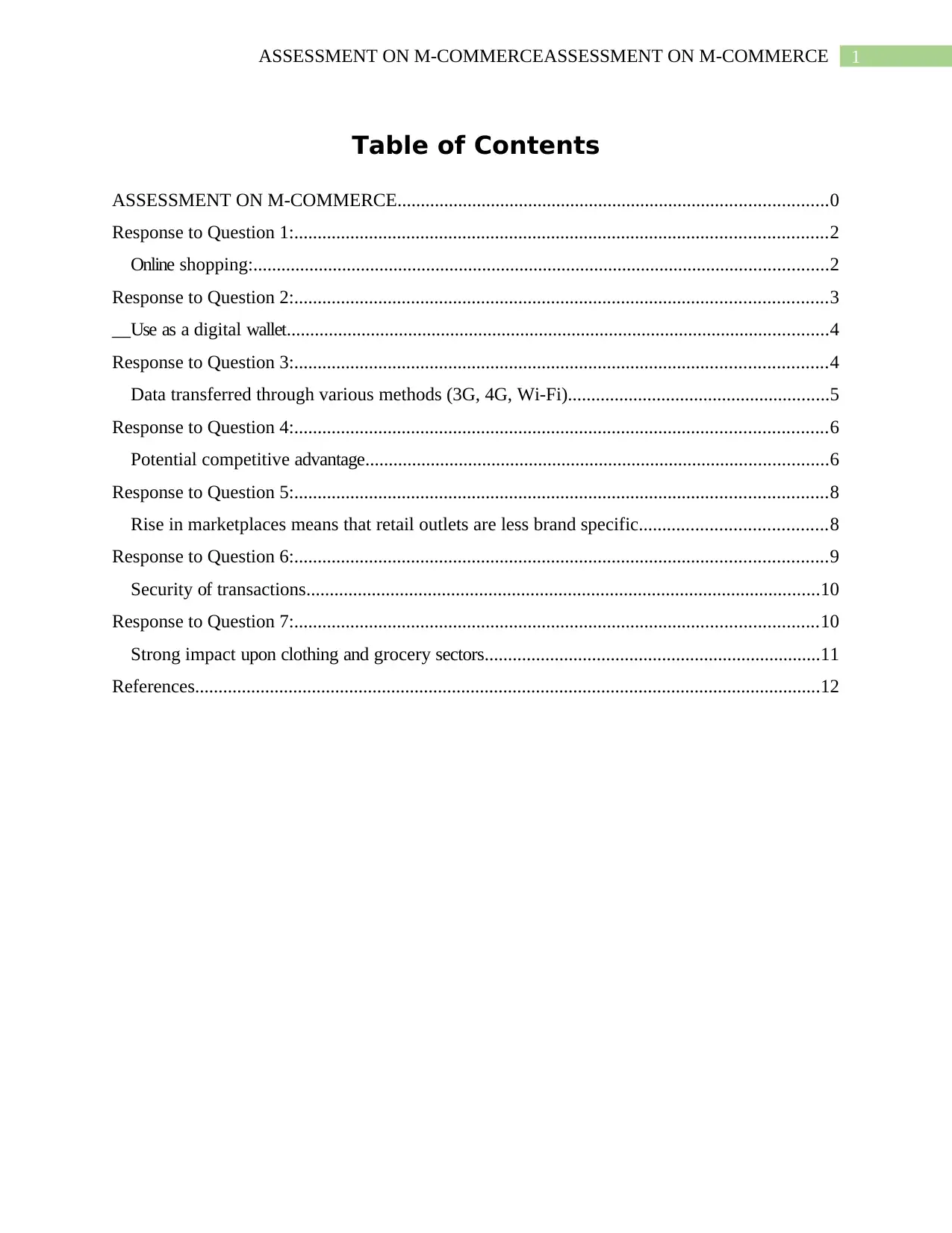
1ASSESSMENT ON M-COMMERCEASSESSMENT ON M-COMMERCE
Table of Contents
ASSESSMENT ON M-COMMERCE............................................................................................0
Response to Question 1:..................................................................................................................2
Online shopping:...........................................................................................................................2
Response to Question 2:..................................................................................................................3
__Use as a digital wallet....................................................................................................................4
Response to Question 3:..................................................................................................................4
Data transferred through various methods (3G, 4G, Wi-Fi)........................................................5
Response to Question 4:..................................................................................................................6
Potential competitive advantage...................................................................................................6
Response to Question 5:..................................................................................................................8
Rise in marketplaces means that retail outlets are less brand specific........................................8
Response to Question 6:..................................................................................................................9
Security of transactions..............................................................................................................10
Response to Question 7:................................................................................................................10
Strong impact upon clothing and grocery sectors........................................................................11
References......................................................................................................................................12
Table of Contents
ASSESSMENT ON M-COMMERCE............................................................................................0
Response to Question 1:..................................................................................................................2
Online shopping:...........................................................................................................................2
Response to Question 2:..................................................................................................................3
__Use as a digital wallet....................................................................................................................4
Response to Question 3:..................................................................................................................4
Data transferred through various methods (3G, 4G, Wi-Fi)........................................................5
Response to Question 4:..................................................................................................................6
Potential competitive advantage...................................................................................................6
Response to Question 5:..................................................................................................................8
Rise in marketplaces means that retail outlets are less brand specific........................................8
Response to Question 6:..................................................................................................................9
Security of transactions..............................................................................................................10
Response to Question 7:................................................................................................................10
Strong impact upon clothing and grocery sectors........................................................................11
References......................................................................................................................................12
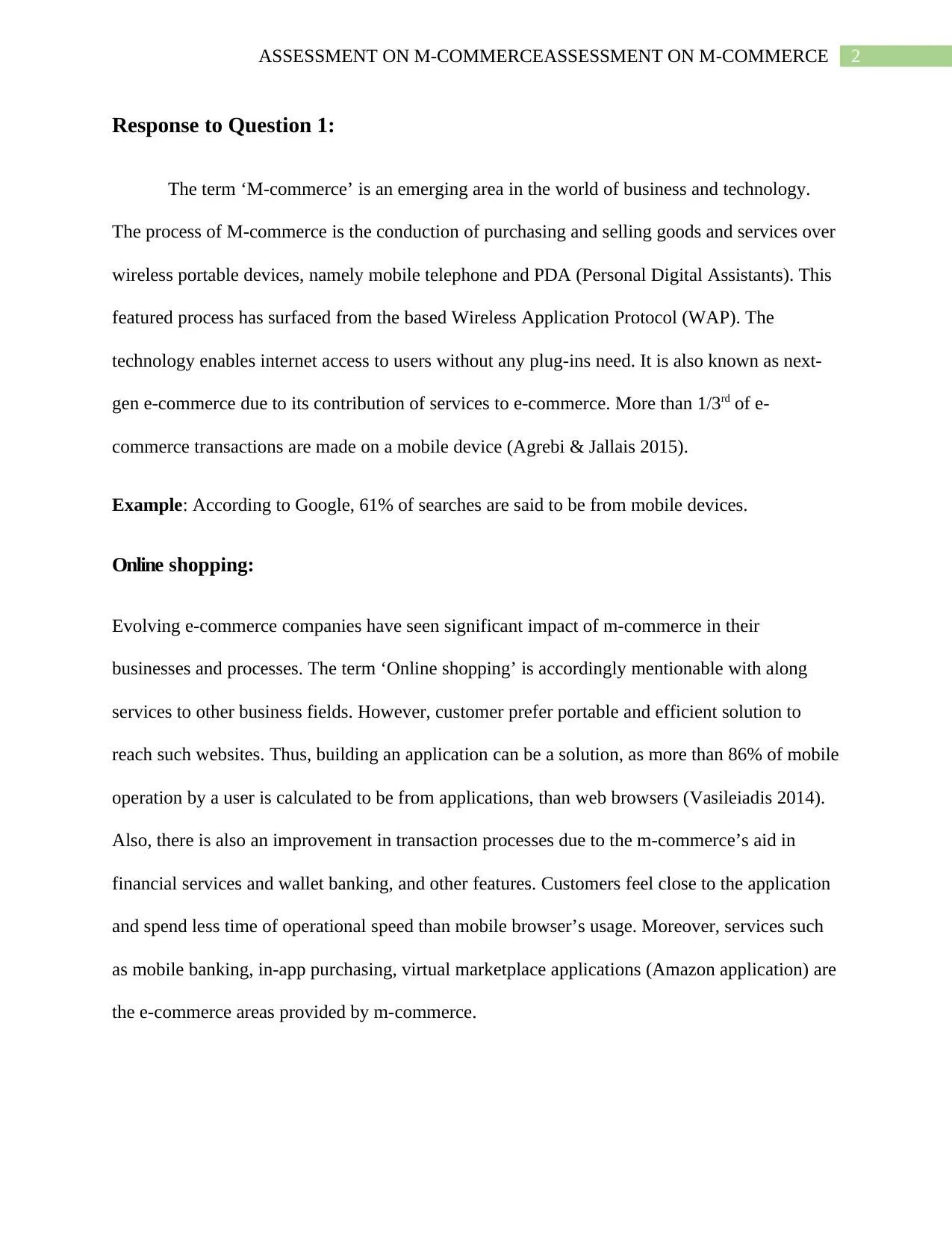
2ASSESSMENT ON M-COMMERCEASSESSMENT ON M-COMMERCE
Response to Question 1:
The term ‘M-commerce’ is an emerging area in the world of business and technology.
The process of M-commerce is the conduction of purchasing and selling goods and services over
wireless portable devices, namely mobile telephone and PDA (Personal Digital Assistants). This
featured process has surfaced from the based Wireless Application Protocol (WAP). The
technology enables internet access to users without any plug-ins need. It is also known as next-
gen e-commerce due to its contribution of services to e-commerce. More than 1/3rd of e-
commerce transactions are made on a mobile device (Agrebi & Jallais 2015).
Example: According to Google, 61% of searches are said to be from mobile devices.
Online shopping:
Evolving e-commerce companies have seen significant impact of m-commerce in their
businesses and processes. The term ‘Online shopping’ is accordingly mentionable with along
services to other business fields. However, customer prefer portable and efficient solution to
reach such websites. Thus, building an application can be a solution, as more than 86% of mobile
operation by a user is calculated to be from applications, than web browsers (Vasileiadis 2014).
Also, there is also an improvement in transaction processes due to the m-commerce’s aid in
financial services and wallet banking, and other features. Customers feel close to the application
and spend less time of operational speed than mobile browser’s usage. Moreover, services such
as mobile banking, in-app purchasing, virtual marketplace applications (Amazon application) are
the e-commerce areas provided by m-commerce.
Response to Question 1:
The term ‘M-commerce’ is an emerging area in the world of business and technology.
The process of M-commerce is the conduction of purchasing and selling goods and services over
wireless portable devices, namely mobile telephone and PDA (Personal Digital Assistants). This
featured process has surfaced from the based Wireless Application Protocol (WAP). The
technology enables internet access to users without any plug-ins need. It is also known as next-
gen e-commerce due to its contribution of services to e-commerce. More than 1/3rd of e-
commerce transactions are made on a mobile device (Agrebi & Jallais 2015).
Example: According to Google, 61% of searches are said to be from mobile devices.
Online shopping:
Evolving e-commerce companies have seen significant impact of m-commerce in their
businesses and processes. The term ‘Online shopping’ is accordingly mentionable with along
services to other business fields. However, customer prefer portable and efficient solution to
reach such websites. Thus, building an application can be a solution, as more than 86% of mobile
operation by a user is calculated to be from applications, than web browsers (Vasileiadis 2014).
Also, there is also an improvement in transaction processes due to the m-commerce’s aid in
financial services and wallet banking, and other features. Customers feel close to the application
and spend less time of operational speed than mobile browser’s usage. Moreover, services such
as mobile banking, in-app purchasing, virtual marketplace applications (Amazon application) are
the e-commerce areas provided by m-commerce.

3ASSESSMENT ON M-COMMERCEASSESSMENT ON M-COMMERCE
Example: Online shopping platforms such as Amazon, eBay, Alibaba group Holding Ltd, etc.
have seen significant increase of 52% in their sales (in a year cycle), after the deployment of m-
commerce roles in their business style. All the m-commerce features are enabled in the
respective applications.
Response to Question 2:
The current retail industry’s focus is to enhance the customer satisfaction and user
experience by the in-hand browsing of the retailer’s respective stores through mobile
applications and, also building customer loyalty. Nowadays, both customers and retailers opt for
a shareable and standard platform which confirms to deliver best business interaction, and the
mobile applications deliver the same. This triggers handful of opportunities to the customized
and personalized purchase experiences to the customers. This is a bright scope, as around 82% of
internet popularized users own a smartphone, while 83% of users have stated to require seamless
experience across all devices. Moreover, m-commerce provides retail enterprises with the
benefits of-
Dynamic Shopping Experience (to the customers)
Personalized Services
Effective Marketing
Addictive nature of the Retail apps
Built-in Features of Smartphones.
Example: All popular shopping websites (Walmart, Amazon, eBay, etc.) have shared multiple
scopes of experiences to their users, via built-in feature, efficiency in marketing, addictive nature
(according to the customer’s statements and analyzed traffic).
Example: Online shopping platforms such as Amazon, eBay, Alibaba group Holding Ltd, etc.
have seen significant increase of 52% in their sales (in a year cycle), after the deployment of m-
commerce roles in their business style. All the m-commerce features are enabled in the
respective applications.
Response to Question 2:
The current retail industry’s focus is to enhance the customer satisfaction and user
experience by the in-hand browsing of the retailer’s respective stores through mobile
applications and, also building customer loyalty. Nowadays, both customers and retailers opt for
a shareable and standard platform which confirms to deliver best business interaction, and the
mobile applications deliver the same. This triggers handful of opportunities to the customized
and personalized purchase experiences to the customers. This is a bright scope, as around 82% of
internet popularized users own a smartphone, while 83% of users have stated to require seamless
experience across all devices. Moreover, m-commerce provides retail enterprises with the
benefits of-
Dynamic Shopping Experience (to the customers)
Personalized Services
Effective Marketing
Addictive nature of the Retail apps
Built-in Features of Smartphones.
Example: All popular shopping websites (Walmart, Amazon, eBay, etc.) have shared multiple
scopes of experiences to their users, via built-in feature, efficiency in marketing, addictive nature
(according to the customer’s statements and analyzed traffic).
Secure Best Marks with AI Grader
Need help grading? Try our AI Grader for instant feedback on your assignments.

4ASSESSMENT ON M-COMMERCEASSESSMENT ON M-COMMERCE
Use as a digital wallet
The transaction process of commerce has been drastically changed by our digital world.
Undoubtedly, digital payment and mobile payment’s spread has accelerated the m-commerce’s
growth. It is expected that the mobile wallets usage will surpass debit and credit cards by 2022.
With the continuous growth, many retailers, payment providers and financial services are
reaching for corrective solutions to mitigate the presently existing risks/limitations. The
limitations are observed to be present in Near Field Communication (NFC) which needs a
specific hardware, which is not initiated in a basic handset. Moreover, these are rare and costly.
Thus, it becomes a problem for the unbanked and underbanked populations, who mostly use
outdated models. Also QR codes and UPI are few lengthy and vulnerable processes during
transaction. Digital wallet applications, are becoming increasingly popular.
Example: Online wallet applications such as Android Pay, Apple Pay, Samsung Pay, and others,
have been deployed by many brands which have created a potential platform for executing online
banking from any location.
Response to Question 3:
Mobile commerce has immense opportunities while providing characteristics like
customer attraction, loyalty earning and product/service sales. However, few unearthed
challenges provide fragmentation to the framework of m-commerce, such as-
Evolution of Devices: Manufacturers (hardware) are always producing better and faster
smartphones. The updated OS are also smarter. Moreover, store owners require to follow
Use as a digital wallet
The transaction process of commerce has been drastically changed by our digital world.
Undoubtedly, digital payment and mobile payment’s spread has accelerated the m-commerce’s
growth. It is expected that the mobile wallets usage will surpass debit and credit cards by 2022.
With the continuous growth, many retailers, payment providers and financial services are
reaching for corrective solutions to mitigate the presently existing risks/limitations. The
limitations are observed to be present in Near Field Communication (NFC) which needs a
specific hardware, which is not initiated in a basic handset. Moreover, these are rare and costly.
Thus, it becomes a problem for the unbanked and underbanked populations, who mostly use
outdated models. Also QR codes and UPI are few lengthy and vulnerable processes during
transaction. Digital wallet applications, are becoming increasingly popular.
Example: Online wallet applications such as Android Pay, Apple Pay, Samsung Pay, and others,
have been deployed by many brands which have created a potential platform for executing online
banking from any location.
Response to Question 3:
Mobile commerce has immense opportunities while providing characteristics like
customer attraction, loyalty earning and product/service sales. However, few unearthed
challenges provide fragmentation to the framework of m-commerce, such as-
Evolution of Devices: Manufacturers (hardware) are always producing better and faster
smartphones. The updated OS are also smarter. Moreover, store owners require to follow
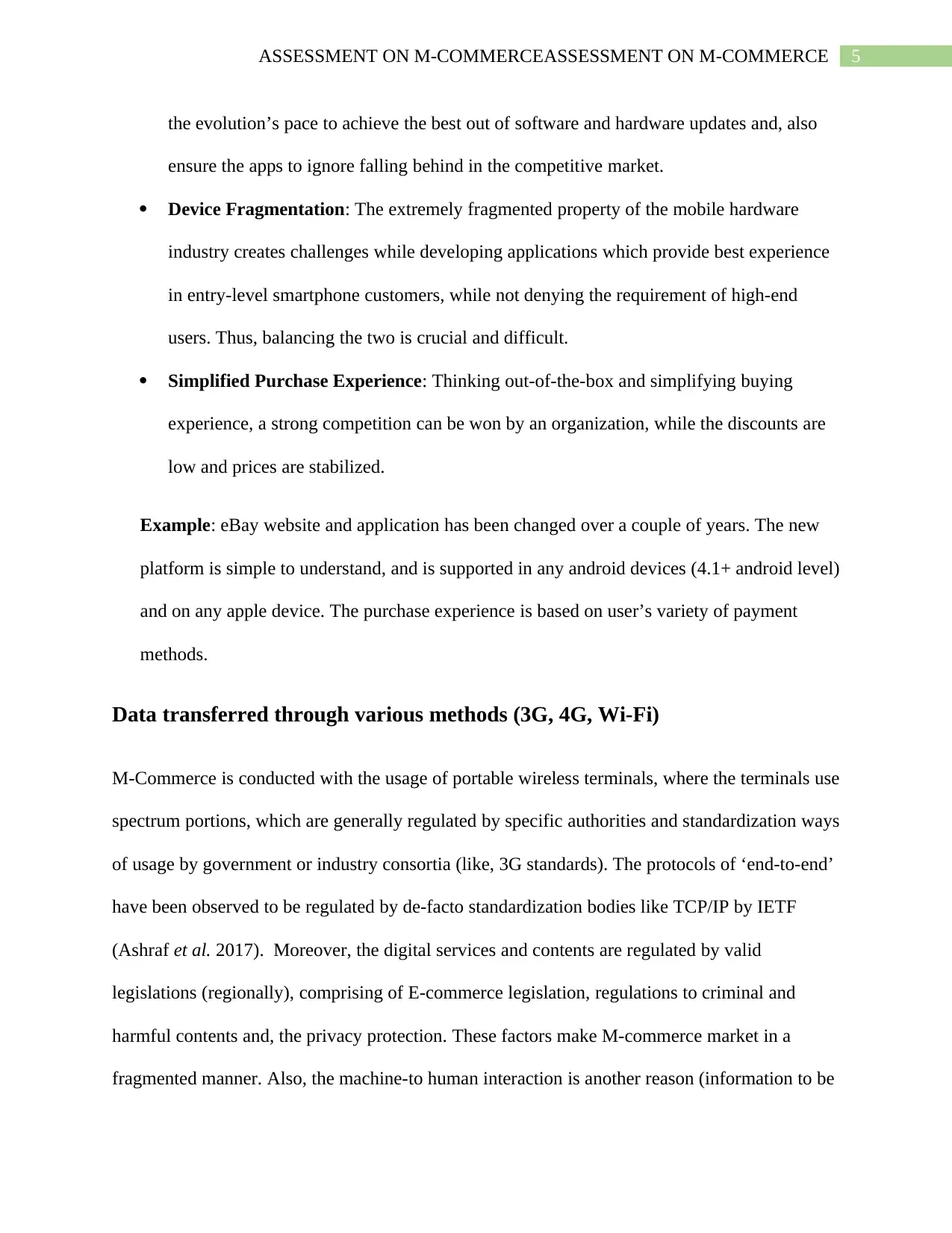
5ASSESSMENT ON M-COMMERCEASSESSMENT ON M-COMMERCE
the evolution’s pace to achieve the best out of software and hardware updates and, also
ensure the apps to ignore falling behind in the competitive market.
Device Fragmentation: The extremely fragmented property of the mobile hardware
industry creates challenges while developing applications which provide best experience
in entry-level smartphone customers, while not denying the requirement of high-end
users. Thus, balancing the two is crucial and difficult.
Simplified Purchase Experience: Thinking out-of-the-box and simplifying buying
experience, a strong competition can be won by an organization, while the discounts are
low and prices are stabilized.
Example: eBay website and application has been changed over a couple of years. The new
platform is simple to understand, and is supported in any android devices (4.1+ android level)
and on any apple device. The purchase experience is based on user’s variety of payment
methods.
Data transferred through various methods (3G, 4G, Wi-Fi)
M-Commerce is conducted with the usage of portable wireless terminals, where the terminals use
spectrum portions, which are generally regulated by specific authorities and standardization ways
of usage by government or industry consortia (like, 3G standards). The protocols of ‘end-to-end’
have been observed to be regulated by de-facto standardization bodies like TCP/IP by IETF
(Ashraf et al. 2017). Moreover, the digital services and contents are regulated by valid
legislations (regionally), comprising of E-commerce legislation, regulations to criminal and
harmful contents and, the privacy protection. These factors make M-commerce market in a
fragmented manner. Also, the machine-to human interaction is another reason (information to be
the evolution’s pace to achieve the best out of software and hardware updates and, also
ensure the apps to ignore falling behind in the competitive market.
Device Fragmentation: The extremely fragmented property of the mobile hardware
industry creates challenges while developing applications which provide best experience
in entry-level smartphone customers, while not denying the requirement of high-end
users. Thus, balancing the two is crucial and difficult.
Simplified Purchase Experience: Thinking out-of-the-box and simplifying buying
experience, a strong competition can be won by an organization, while the discounts are
low and prices are stabilized.
Example: eBay website and application has been changed over a couple of years. The new
platform is simple to understand, and is supported in any android devices (4.1+ android level)
and on any apple device. The purchase experience is based on user’s variety of payment
methods.
Data transferred through various methods (3G, 4G, Wi-Fi)
M-Commerce is conducted with the usage of portable wireless terminals, where the terminals use
spectrum portions, which are generally regulated by specific authorities and standardization ways
of usage by government or industry consortia (like, 3G standards). The protocols of ‘end-to-end’
have been observed to be regulated by de-facto standardization bodies like TCP/IP by IETF
(Ashraf et al. 2017). Moreover, the digital services and contents are regulated by valid
legislations (regionally), comprising of E-commerce legislation, regulations to criminal and
harmful contents and, the privacy protection. These factors make M-commerce market in a
fragmented manner. Also, the machine-to human interaction is another reason (information to be
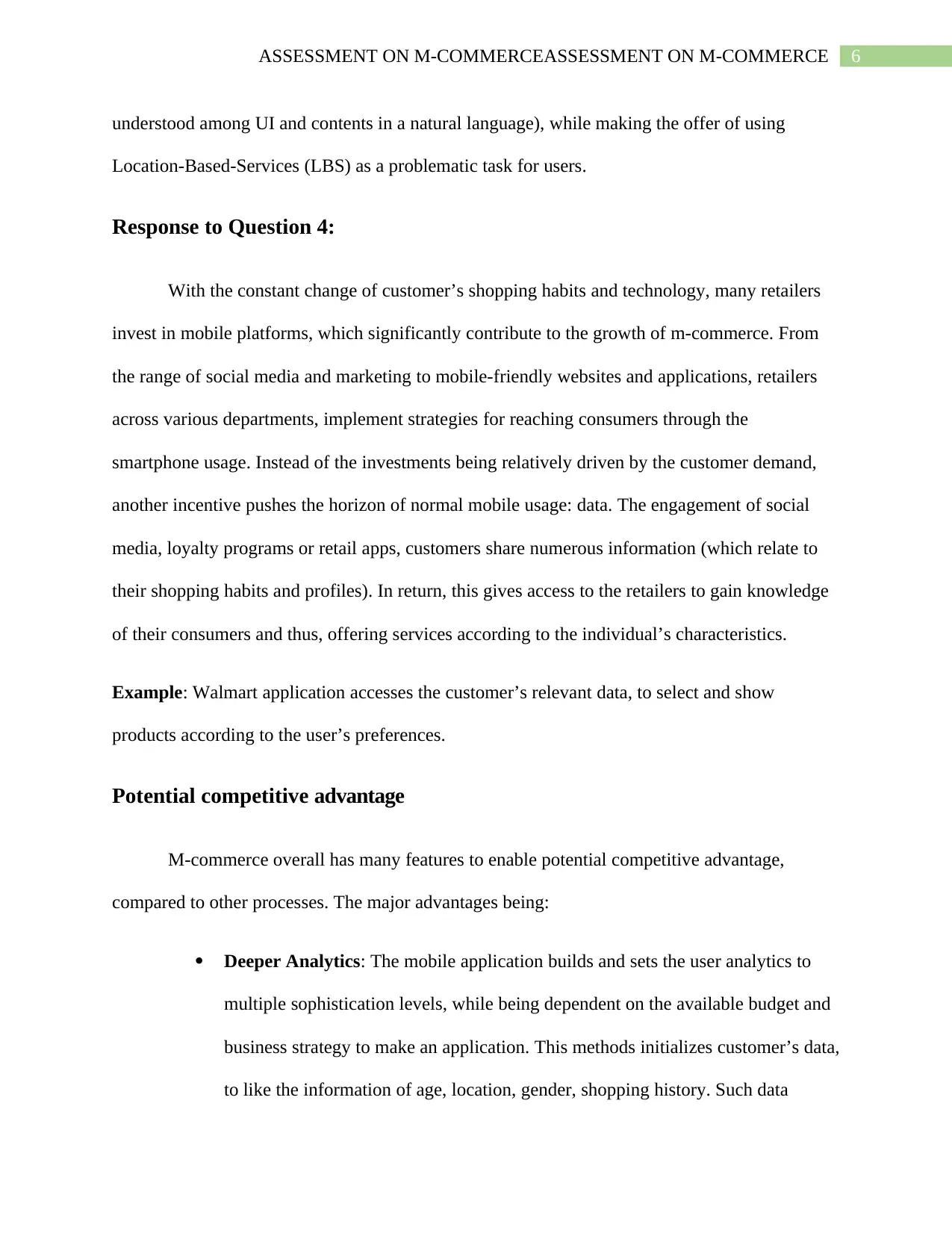
6ASSESSMENT ON M-COMMERCEASSESSMENT ON M-COMMERCE
understood among UI and contents in a natural language), while making the offer of using
Location-Based-Services (LBS) as a problematic task for users.
Response to Question 4:
With the constant change of customer’s shopping habits and technology, many retailers
invest in mobile platforms, which significantly contribute to the growth of m-commerce. From
the range of social media and marketing to mobile-friendly websites and applications, retailers
across various departments, implement strategies for reaching consumers through the
smartphone usage. Instead of the investments being relatively driven by the customer demand,
another incentive pushes the horizon of normal mobile usage: data. The engagement of social
media, loyalty programs or retail apps, customers share numerous information (which relate to
their shopping habits and profiles). In return, this gives access to the retailers to gain knowledge
of their consumers and thus, offering services according to the individual’s characteristics.
Example: Walmart application accesses the customer’s relevant data, to select and show
products according to the user’s preferences.
Potential competitive advantage
M-commerce overall has many features to enable potential competitive advantage,
compared to other processes. The major advantages being:
Deeper Analytics: The mobile application builds and sets the user analytics to
multiple sophistication levels, while being dependent on the available budget and
business strategy to make an application. This methods initializes customer’s data,
to like the information of age, location, gender, shopping history. Such data
understood among UI and contents in a natural language), while making the offer of using
Location-Based-Services (LBS) as a problematic task for users.
Response to Question 4:
With the constant change of customer’s shopping habits and technology, many retailers
invest in mobile platforms, which significantly contribute to the growth of m-commerce. From
the range of social media and marketing to mobile-friendly websites and applications, retailers
across various departments, implement strategies for reaching consumers through the
smartphone usage. Instead of the investments being relatively driven by the customer demand,
another incentive pushes the horizon of normal mobile usage: data. The engagement of social
media, loyalty programs or retail apps, customers share numerous information (which relate to
their shopping habits and profiles). In return, this gives access to the retailers to gain knowledge
of their consumers and thus, offering services according to the individual’s characteristics.
Example: Walmart application accesses the customer’s relevant data, to select and show
products according to the user’s preferences.
Potential competitive advantage
M-commerce overall has many features to enable potential competitive advantage,
compared to other processes. The major advantages being:
Deeper Analytics: The mobile application builds and sets the user analytics to
multiple sophistication levels, while being dependent on the available budget and
business strategy to make an application. This methods initializes customer’s data,
to like the information of age, location, gender, shopping history. Such data
Paraphrase This Document
Need a fresh take? Get an instant paraphrase of this document with our AI Paraphraser
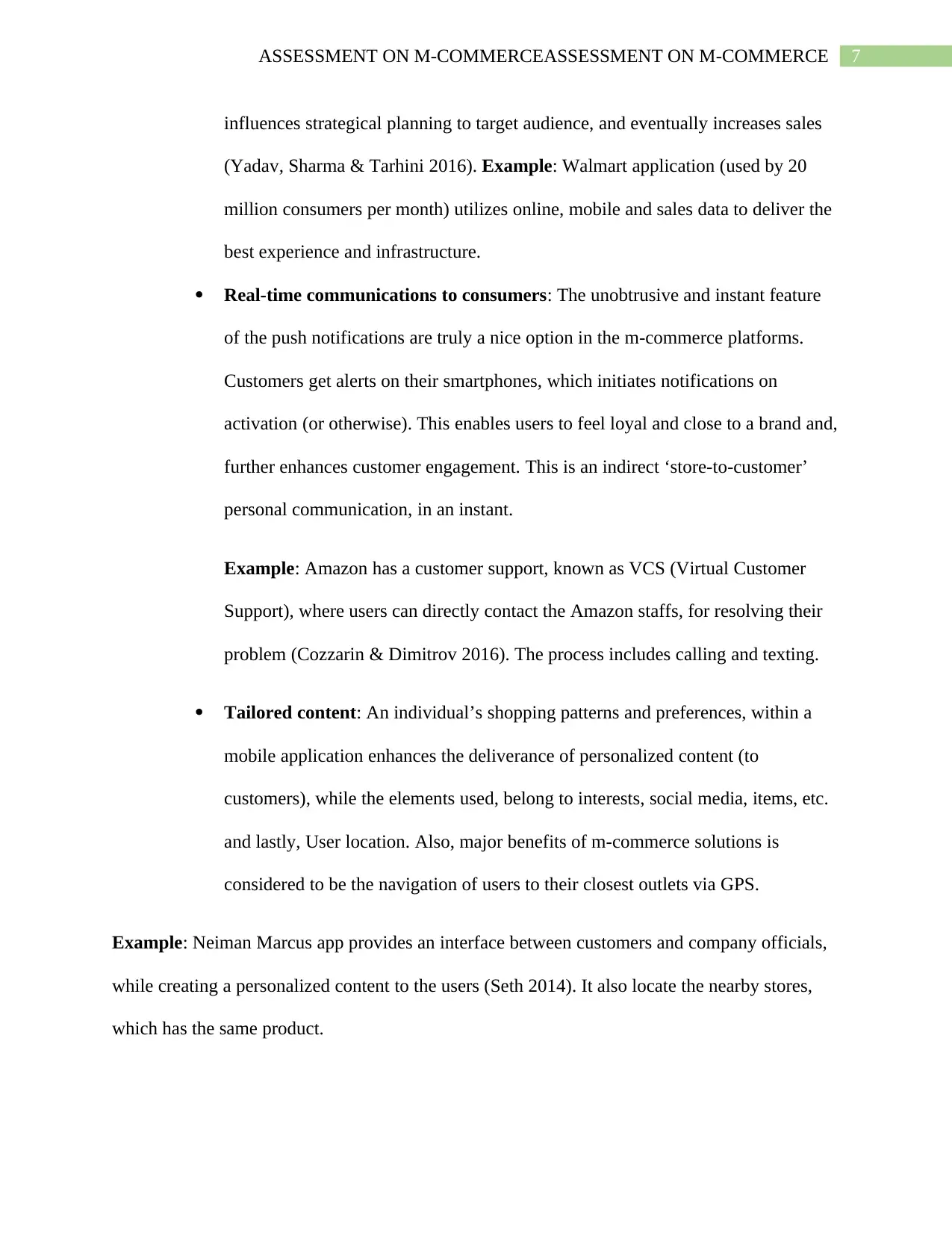
7ASSESSMENT ON M-COMMERCEASSESSMENT ON M-COMMERCE
influences strategical planning to target audience, and eventually increases sales
(Yadav, Sharma & Tarhini 2016). Example: Walmart application (used by 20
million consumers per month) utilizes online, mobile and sales data to deliver the
best experience and infrastructure.
Real-time communications to consumers: The unobtrusive and instant feature
of the push notifications are truly a nice option in the m-commerce platforms.
Customers get alerts on their smartphones, which initiates notifications on
activation (or otherwise). This enables users to feel loyal and close to a brand and,
further enhances customer engagement. This is an indirect ‘store-to-customer’
personal communication, in an instant.
Example: Amazon has a customer support, known as VCS (Virtual Customer
Support), where users can directly contact the Amazon staffs, for resolving their
problem (Cozzarin & Dimitrov 2016). The process includes calling and texting.
Tailored content: An individual’s shopping patterns and preferences, within a
mobile application enhances the deliverance of personalized content (to
customers), while the elements used, belong to interests, social media, items, etc.
and lastly, User location. Also, major benefits of m-commerce solutions is
considered to be the navigation of users to their closest outlets via GPS.
Example: Neiman Marcus app provides an interface between customers and company officials,
while creating a personalized content to the users (Seth 2014). It also locate the nearby stores,
which has the same product.
influences strategical planning to target audience, and eventually increases sales
(Yadav, Sharma & Tarhini 2016). Example: Walmart application (used by 20
million consumers per month) utilizes online, mobile and sales data to deliver the
best experience and infrastructure.
Real-time communications to consumers: The unobtrusive and instant feature
of the push notifications are truly a nice option in the m-commerce platforms.
Customers get alerts on their smartphones, which initiates notifications on
activation (or otherwise). This enables users to feel loyal and close to a brand and,
further enhances customer engagement. This is an indirect ‘store-to-customer’
personal communication, in an instant.
Example: Amazon has a customer support, known as VCS (Virtual Customer
Support), where users can directly contact the Amazon staffs, for resolving their
problem (Cozzarin & Dimitrov 2016). The process includes calling and texting.
Tailored content: An individual’s shopping patterns and preferences, within a
mobile application enhances the deliverance of personalized content (to
customers), while the elements used, belong to interests, social media, items, etc.
and lastly, User location. Also, major benefits of m-commerce solutions is
considered to be the navigation of users to their closest outlets via GPS.
Example: Neiman Marcus app provides an interface between customers and company officials,
while creating a personalized content to the users (Seth 2014). It also locate the nearby stores,
which has the same product.
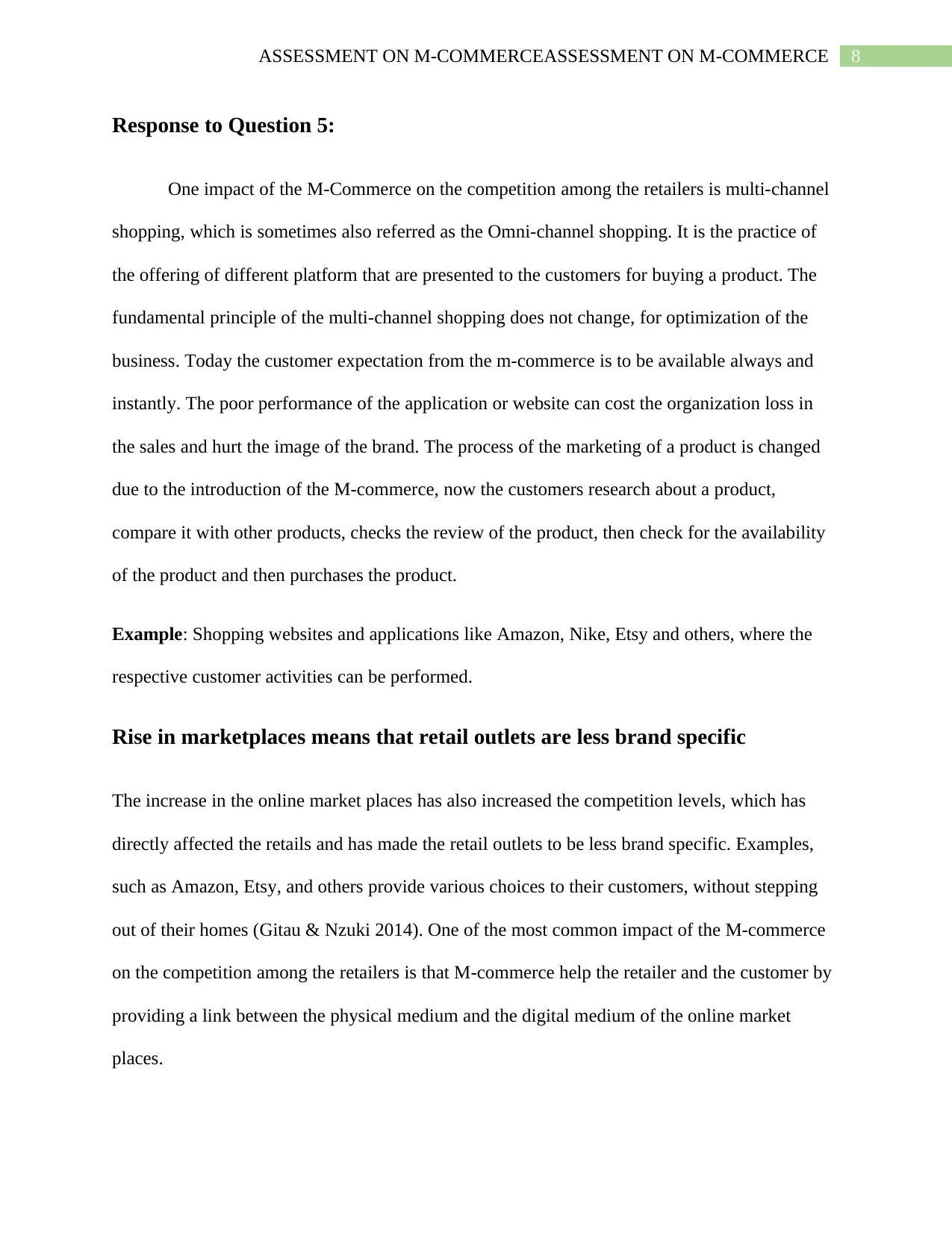
8ASSESSMENT ON M-COMMERCEASSESSMENT ON M-COMMERCE
Response to Question 5:
One impact of the M-Commerce on the competition among the retailers is multi-channel
shopping, which is sometimes also referred as the Omni-channel shopping. It is the practice of
the offering of different platform that are presented to the customers for buying a product. The
fundamental principle of the multi-channel shopping does not change, for optimization of the
business. Today the customer expectation from the m-commerce is to be available always and
instantly. The poor performance of the application or website can cost the organization loss in
the sales and hurt the image of the brand. The process of the marketing of a product is changed
due to the introduction of the M-commerce, now the customers research about a product,
compare it with other products, checks the review of the product, then check for the availability
of the product and then purchases the product.
Example: Shopping websites and applications like Amazon, Nike, Etsy and others, where the
respective customer activities can be performed.
Rise in marketplaces means that retail outlets are less brand specific
The increase in the online market places has also increased the competition levels, which has
directly affected the retails and has made the retail outlets to be less brand specific. Examples,
such as Amazon, Etsy, and others provide various choices to their customers, without stepping
out of their homes (Gitau & Nzuki 2014). One of the most common impact of the M-commerce
on the competition among the retailers is that M-commerce help the retailer and the customer by
providing a link between the physical medium and the digital medium of the online market
places.
Response to Question 5:
One impact of the M-Commerce on the competition among the retailers is multi-channel
shopping, which is sometimes also referred as the Omni-channel shopping. It is the practice of
the offering of different platform that are presented to the customers for buying a product. The
fundamental principle of the multi-channel shopping does not change, for optimization of the
business. Today the customer expectation from the m-commerce is to be available always and
instantly. The poor performance of the application or website can cost the organization loss in
the sales and hurt the image of the brand. The process of the marketing of a product is changed
due to the introduction of the M-commerce, now the customers research about a product,
compare it with other products, checks the review of the product, then check for the availability
of the product and then purchases the product.
Example: Shopping websites and applications like Amazon, Nike, Etsy and others, where the
respective customer activities can be performed.
Rise in marketplaces means that retail outlets are less brand specific
The increase in the online market places has also increased the competition levels, which has
directly affected the retails and has made the retail outlets to be less brand specific. Examples,
such as Amazon, Etsy, and others provide various choices to their customers, without stepping
out of their homes (Gitau & Nzuki 2014). One of the most common impact of the M-commerce
on the competition among the retailers is that M-commerce help the retailer and the customer by
providing a link between the physical medium and the digital medium of the online market
places.
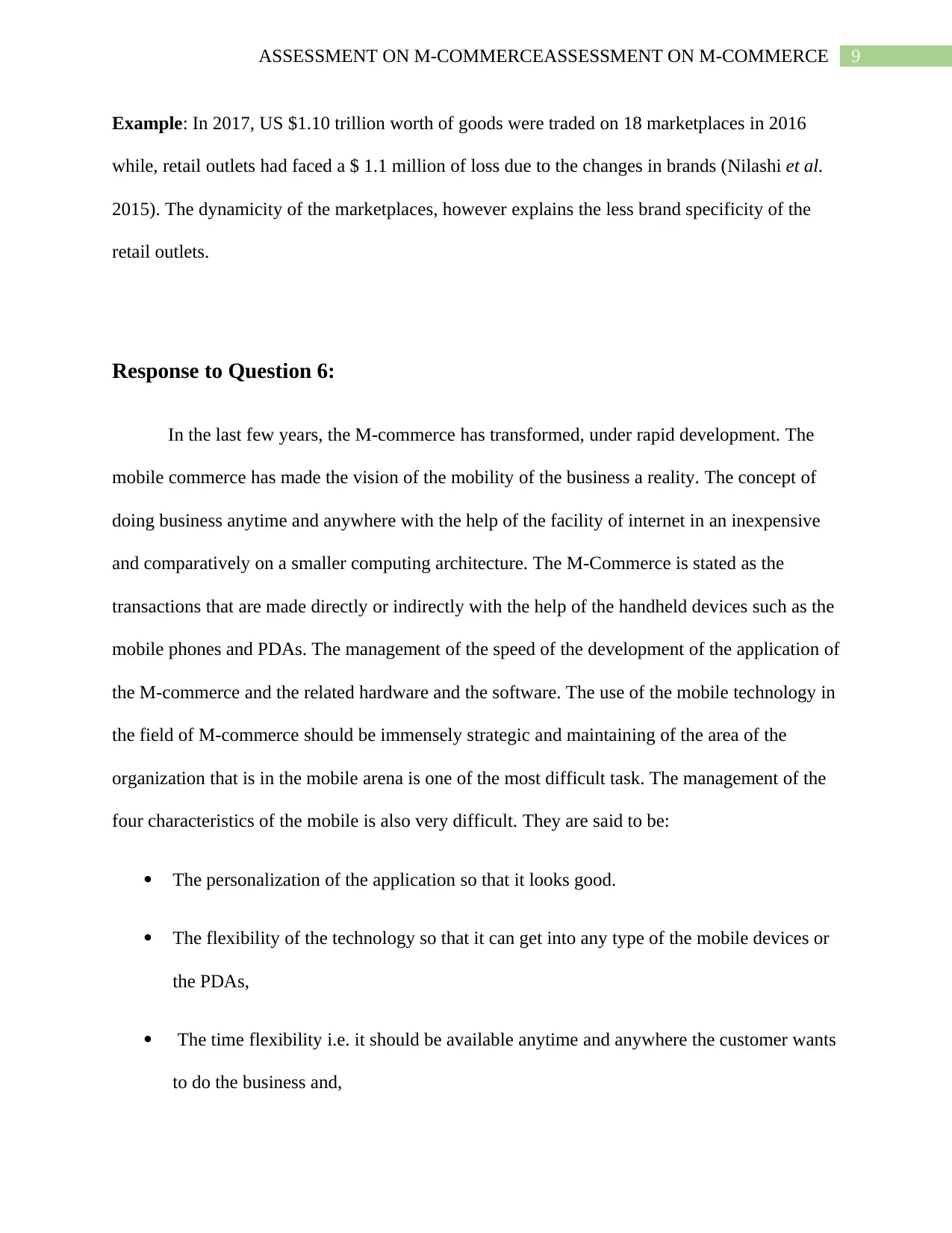
9ASSESSMENT ON M-COMMERCEASSESSMENT ON M-COMMERCE
Example: In 2017, US $1.10 trillion worth of goods were traded on 18 marketplaces in 2016
while, retail outlets had faced a $ 1.1 million of loss due to the changes in brands (Nilashi et al.
2015). The dynamicity of the marketplaces, however explains the less brand specificity of the
retail outlets.
Response to Question 6:
In the last few years, the M-commerce has transformed, under rapid development. The
mobile commerce has made the vision of the mobility of the business a reality. The concept of
doing business anytime and anywhere with the help of the facility of internet in an inexpensive
and comparatively on a smaller computing architecture. The M-Commerce is stated as the
transactions that are made directly or indirectly with the help of the handheld devices such as the
mobile phones and PDAs. The management of the speed of the development of the application of
the M-commerce and the related hardware and the software. The use of the mobile technology in
the field of M-commerce should be immensely strategic and maintaining of the area of the
organization that is in the mobile arena is one of the most difficult task. The management of the
four characteristics of the mobile is also very difficult. They are said to be:
The personalization of the application so that it looks good.
The flexibility of the technology so that it can get into any type of the mobile devices or
the PDAs,
The time flexibility i.e. it should be available anytime and anywhere the customer wants
to do the business and,
Example: In 2017, US $1.10 trillion worth of goods were traded on 18 marketplaces in 2016
while, retail outlets had faced a $ 1.1 million of loss due to the changes in brands (Nilashi et al.
2015). The dynamicity of the marketplaces, however explains the less brand specificity of the
retail outlets.
Response to Question 6:
In the last few years, the M-commerce has transformed, under rapid development. The
mobile commerce has made the vision of the mobility of the business a reality. The concept of
doing business anytime and anywhere with the help of the facility of internet in an inexpensive
and comparatively on a smaller computing architecture. The M-Commerce is stated as the
transactions that are made directly or indirectly with the help of the handheld devices such as the
mobile phones and PDAs. The management of the speed of the development of the application of
the M-commerce and the related hardware and the software. The use of the mobile technology in
the field of M-commerce should be immensely strategic and maintaining of the area of the
organization that is in the mobile arena is one of the most difficult task. The management of the
four characteristics of the mobile is also very difficult. They are said to be:
The personalization of the application so that it looks good.
The flexibility of the technology so that it can get into any type of the mobile devices or
the PDAs,
The time flexibility i.e. it should be available anytime and anywhere the customer wants
to do the business and,
Secure Best Marks with AI Grader
Need help grading? Try our AI Grader for instant feedback on your assignments.

10ASSESSMENT ON M-COMMERCEASSESSMENT ON M-COMMERCE
The localization of the application.
Example: Current applications like Q, Cover, Starbucks, and others, provide user will
personalization of the content, via definitive choices and flexibility to move to other devices
(Cao et al. 2015). Also, localization is supported.
Security of transactions
One of the important challenges that is faced in the management of the mobile technology,
security of the transaction, if the transaction is made on the website or the application of the
organization and the payment is debited from customer but not set to the organization then who
is to be blamed is a very important question (Köster, Matt & Hess 2016). The implementation of
the Multi-channel and the multi-platform technologies is also a very difficult problem to be
looked after, as the implementation of the multi-channel technology is very complex. The
handling of the data with the help of the Big Data is also a big concern in the field as the storing
of the data, the privacy of the data and protection of the data from the external threats are also
considered to be difficult. Example: Numerous online marketplace’s transaction process (eBay,
Amazon, Nike), where the security is maintained, however can be breached, if a breakthrough is
met.
Response to Question 7:
The M-commerce is the extended version of the E-commerce, which allow the user to
sell or buy a product over the mobile devices such as the PDAs and smartphone using the
internet. The promotional activities and the purchases both are included in the M-commerce. The
M-commerce is much more convenient and easy to utilize than the E-commerce as it has some
The localization of the application.
Example: Current applications like Q, Cover, Starbucks, and others, provide user will
personalization of the content, via definitive choices and flexibility to move to other devices
(Cao et al. 2015). Also, localization is supported.
Security of transactions
One of the important challenges that is faced in the management of the mobile technology,
security of the transaction, if the transaction is made on the website or the application of the
organization and the payment is debited from customer but not set to the organization then who
is to be blamed is a very important question (Köster, Matt & Hess 2016). The implementation of
the Multi-channel and the multi-platform technologies is also a very difficult problem to be
looked after, as the implementation of the multi-channel technology is very complex. The
handling of the data with the help of the Big Data is also a big concern in the field as the storing
of the data, the privacy of the data and protection of the data from the external threats are also
considered to be difficult. Example: Numerous online marketplace’s transaction process (eBay,
Amazon, Nike), where the security is maintained, however can be breached, if a breakthrough is
met.
Response to Question 7:
The M-commerce is the extended version of the E-commerce, which allow the user to
sell or buy a product over the mobile devices such as the PDAs and smartphone using the
internet. The promotional activities and the purchases both are included in the M-commerce. The
M-commerce is much more convenient and easy to utilize than the E-commerce as it has some
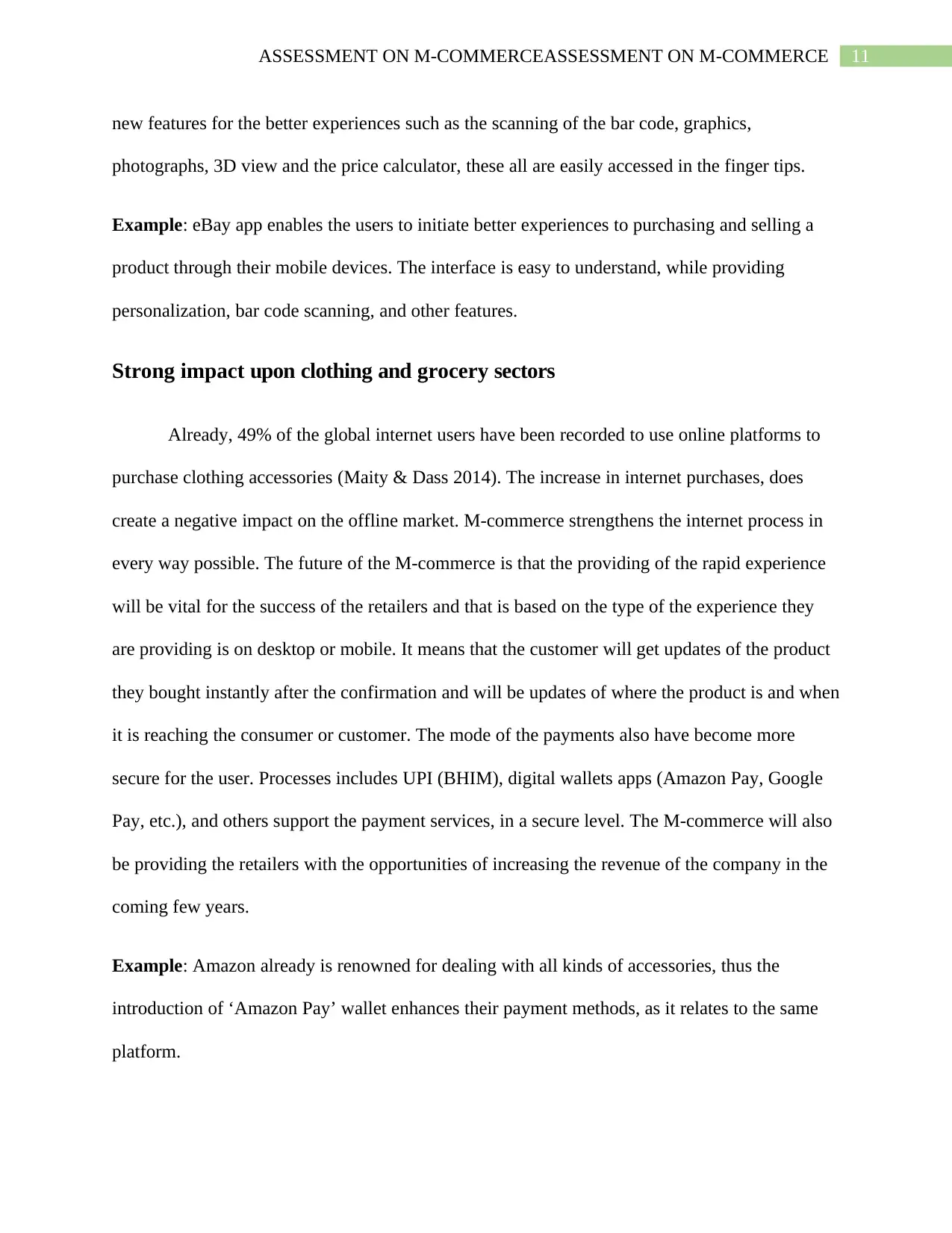
11ASSESSMENT ON M-COMMERCEASSESSMENT ON M-COMMERCE
new features for the better experiences such as the scanning of the bar code, graphics,
photographs, 3D view and the price calculator, these all are easily accessed in the finger tips.
Example: eBay app enables the users to initiate better experiences to purchasing and selling a
product through their mobile devices. The interface is easy to understand, while providing
personalization, bar code scanning, and other features.
Strong impact upon clothing and grocery sectors
Already, 49% of the global internet users have been recorded to use online platforms to
purchase clothing accessories (Maity & Dass 2014). The increase in internet purchases, does
create a negative impact on the offline market. M-commerce strengthens the internet process in
every way possible. The future of the M-commerce is that the providing of the rapid experience
will be vital for the success of the retailers and that is based on the type of the experience they
are providing is on desktop or mobile. It means that the customer will get updates of the product
they bought instantly after the confirmation and will be updates of where the product is and when
it is reaching the consumer or customer. The mode of the payments also have become more
secure for the user. Processes includes UPI (BHIM), digital wallets apps (Amazon Pay, Google
Pay, etc.), and others support the payment services, in a secure level. The M-commerce will also
be providing the retailers with the opportunities of increasing the revenue of the company in the
coming few years.
Example: Amazon already is renowned for dealing with all kinds of accessories, thus the
introduction of ‘Amazon Pay’ wallet enhances their payment methods, as it relates to the same
platform.
new features for the better experiences such as the scanning of the bar code, graphics,
photographs, 3D view and the price calculator, these all are easily accessed in the finger tips.
Example: eBay app enables the users to initiate better experiences to purchasing and selling a
product through their mobile devices. The interface is easy to understand, while providing
personalization, bar code scanning, and other features.
Strong impact upon clothing and grocery sectors
Already, 49% of the global internet users have been recorded to use online platforms to
purchase clothing accessories (Maity & Dass 2014). The increase in internet purchases, does
create a negative impact on the offline market. M-commerce strengthens the internet process in
every way possible. The future of the M-commerce is that the providing of the rapid experience
will be vital for the success of the retailers and that is based on the type of the experience they
are providing is on desktop or mobile. It means that the customer will get updates of the product
they bought instantly after the confirmation and will be updates of where the product is and when
it is reaching the consumer or customer. The mode of the payments also have become more
secure for the user. Processes includes UPI (BHIM), digital wallets apps (Amazon Pay, Google
Pay, etc.), and others support the payment services, in a secure level. The M-commerce will also
be providing the retailers with the opportunities of increasing the revenue of the company in the
coming few years.
Example: Amazon already is renowned for dealing with all kinds of accessories, thus the
introduction of ‘Amazon Pay’ wallet enhances their payment methods, as it relates to the same
platform.
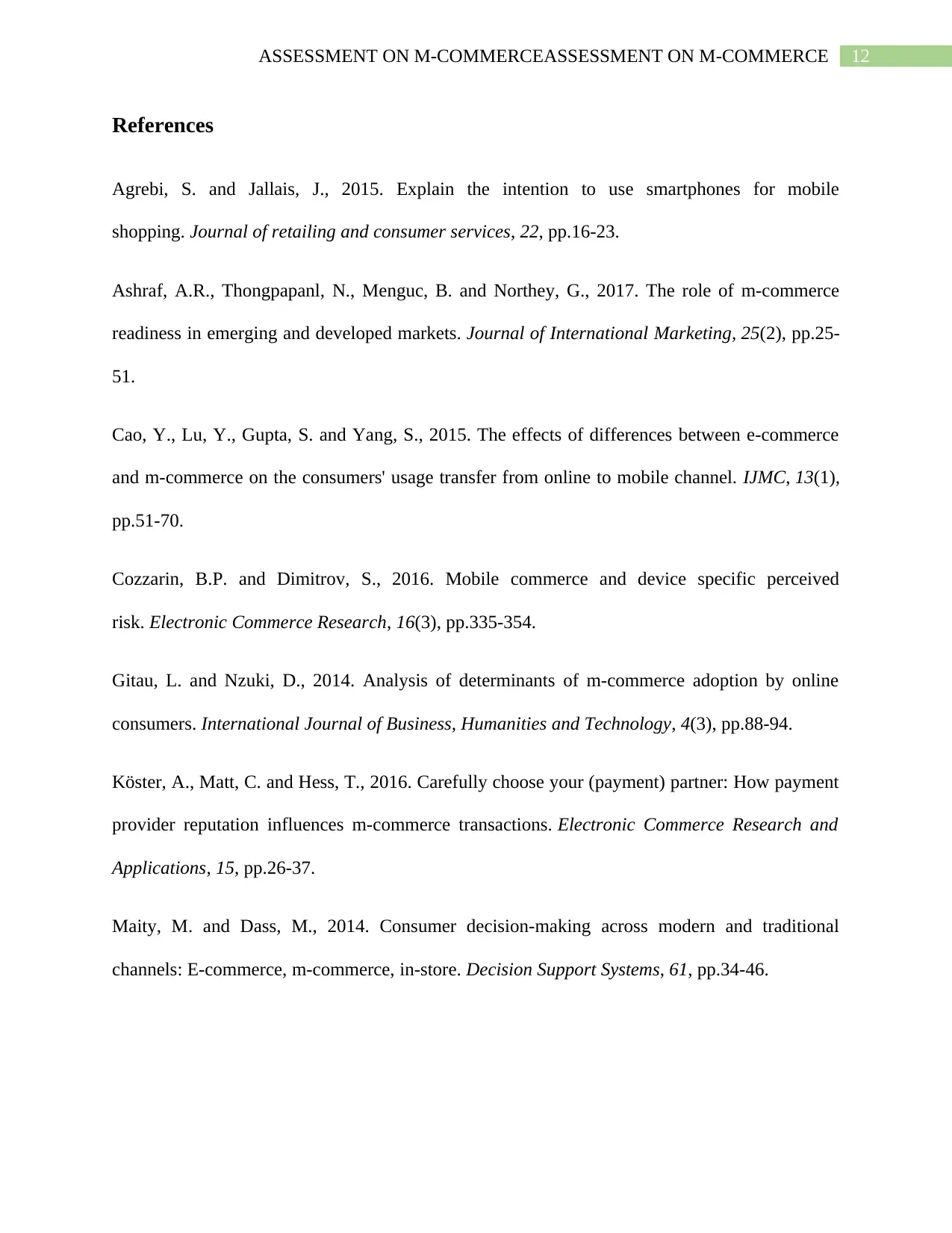
12ASSESSMENT ON M-COMMERCEASSESSMENT ON M-COMMERCE
References
Agrebi, S. and Jallais, J., 2015. Explain the intention to use smartphones for mobile
shopping. Journal of retailing and consumer services, 22, pp.16-23.
Ashraf, A.R., Thongpapanl, N., Menguc, B. and Northey, G., 2017. The role of m-commerce
readiness in emerging and developed markets. Journal of International Marketing, 25(2), pp.25-
51.
Cao, Y., Lu, Y., Gupta, S. and Yang, S., 2015. The effects of differences between e-commerce
and m-commerce on the consumers' usage transfer from online to mobile channel. IJMC, 13(1),
pp.51-70.
Cozzarin, B.P. and Dimitrov, S., 2016. Mobile commerce and device specific perceived
risk. Electronic Commerce Research, 16(3), pp.335-354.
Gitau, L. and Nzuki, D., 2014. Analysis of determinants of m-commerce adoption by online
consumers. International Journal of Business, Humanities and Technology, 4(3), pp.88-94.
Köster, A., Matt, C. and Hess, T., 2016. Carefully choose your (payment) partner: How payment
provider reputation influences m-commerce transactions. Electronic Commerce Research and
Applications, 15, pp.26-37.
Maity, M. and Dass, M., 2014. Consumer decision-making across modern and traditional
channels: E-commerce, m-commerce, in-store. Decision Support Systems, 61, pp.34-46.
References
Agrebi, S. and Jallais, J., 2015. Explain the intention to use smartphones for mobile
shopping. Journal of retailing and consumer services, 22, pp.16-23.
Ashraf, A.R., Thongpapanl, N., Menguc, B. and Northey, G., 2017. The role of m-commerce
readiness in emerging and developed markets. Journal of International Marketing, 25(2), pp.25-
51.
Cao, Y., Lu, Y., Gupta, S. and Yang, S., 2015. The effects of differences between e-commerce
and m-commerce on the consumers' usage transfer from online to mobile channel. IJMC, 13(1),
pp.51-70.
Cozzarin, B.P. and Dimitrov, S., 2016. Mobile commerce and device specific perceived
risk. Electronic Commerce Research, 16(3), pp.335-354.
Gitau, L. and Nzuki, D., 2014. Analysis of determinants of m-commerce adoption by online
consumers. International Journal of Business, Humanities and Technology, 4(3), pp.88-94.
Köster, A., Matt, C. and Hess, T., 2016. Carefully choose your (payment) partner: How payment
provider reputation influences m-commerce transactions. Electronic Commerce Research and
Applications, 15, pp.26-37.
Maity, M. and Dass, M., 2014. Consumer decision-making across modern and traditional
channels: E-commerce, m-commerce, in-store. Decision Support Systems, 61, pp.34-46.
Paraphrase This Document
Need a fresh take? Get an instant paraphrase of this document with our AI Paraphraser

13ASSESSMENT ON M-COMMERCEASSESSMENT ON M-COMMERCE
Nilashi, M., Ibrahim, O., Mirabi, V.R., Ebrahimi, L. and Zare, M., 2015. The role of Security,
Design and Content factors on customer trust in mobile commerce. Journal of Retailing and
Consumer Services, 26, pp.57-69.
Seth, E., 2014. Mobile commerce: A broader perspective. IT Professional, 16(3), pp.61-65.
Vasileiadis, A., 2014. Security concerns and trust in the adoption of m-commerce. Social
technologies, 4(1), pp.179-191.
Yadav, R., Sharma, S.K. and Tarhini, A., 2016. A multi-analytical approach to understand and
predict the mobile commerce adoption. Journal of enterprise information management, 29(2),
pp.222-237.
Nilashi, M., Ibrahim, O., Mirabi, V.R., Ebrahimi, L. and Zare, M., 2015. The role of Security,
Design and Content factors on customer trust in mobile commerce. Journal of Retailing and
Consumer Services, 26, pp.57-69.
Seth, E., 2014. Mobile commerce: A broader perspective. IT Professional, 16(3), pp.61-65.
Vasileiadis, A., 2014. Security concerns and trust in the adoption of m-commerce. Social
technologies, 4(1), pp.179-191.
Yadav, R., Sharma, S.K. and Tarhini, A., 2016. A multi-analytical approach to understand and
predict the mobile commerce adoption. Journal of enterprise information management, 29(2),
pp.222-237.
1 out of 14
Related Documents
Your All-in-One AI-Powered Toolkit for Academic Success.
+13062052269
info@desklib.com
Available 24*7 on WhatsApp / Email
![[object Object]](/_next/static/media/star-bottom.7253800d.svg)
Unlock your academic potential
© 2024 | Zucol Services PVT LTD | All rights reserved.





